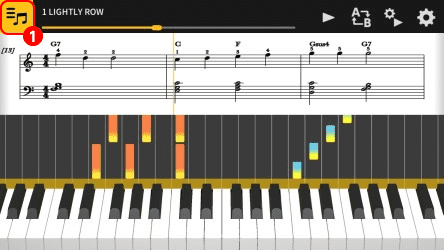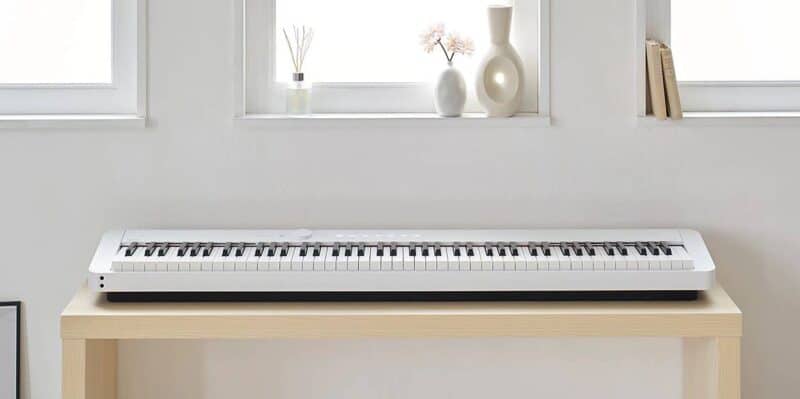Introduction
Hello and welcome to another piano comparison piece. Today we’ve got a shootout for Yamaha P125 vs Casio PX-S1000 88-Key digital pianos. Both digital pianos come in under the $1,000 CAD mark, and both are best sellers with lots of fans all around the world. The P125 is especially a huge seller on Amazon.
We’ll cover all of the relevant factors you’ll want to be considered when selecting a piano, so if these two models are on your shortlist, hopefully, this article can provide some guidance as to which model might be a better fit.
Please feel free to check out our separate PX-S1000 and Yamaha P125 reviews as well.
Let’s jump right in and start by comparing the sound engines of the Yamaha P125 vs Casio PX-S1000.
Yamaha P125 vs Casio PX-S1000 | Piano Sound Engines
Polyphony
Let’s start by comparing some sound-related specs. Polyphony on the P-125 and the PX-S1000 are neck and neck with 192-note polyphony.
It’s pretty incredible to be able to get 192 notes of polyphony in this price category since we’re now at a point where microprocessors have dropped in price and we’re starting to finally benefit from it in the consumer market down in this price range.
Tones
When it comes to the number of tones, we’re also pretty evenly matched, though the P125 has a few more with 24 compared to the PX-S1000’s 18.
Speaker System
As far as the onboard speaker systems go, there is some really interesting technology that Casio is bringing. It’s less about the power of the speaker although, to be fair to Casio, they’ve equipped the S1000 with eight watts per side, whereas the P125 has 7 watts per side (but has 2 extra tweeters), but on top of that, Casio has clearly spent a lot of time digging into simulating spaces and simulating the reverb effects of various settings for a super authentic experience.
The main grand piano sound is well recorded and well rendered, but then by activating Sound Mode, you’re essentially given access to some different reverb presets and hall simulators that really change the sound.

Casio PX-S1000 Control Surface
The PX-S1000 has a unique, minimalist control surface, so if you’d like to avoid shortcut commands, you can use Casio’s Chordana Play for Piano app to essentially remote control the piano from an iOS device like an iPhone or iPad, or an Android device. It’s a well-laid-out app and makes navigating the sounds and features much easier.
All in all, the PX-S1000 is pretty impressive and pretty satisfying to play as a pianist. Now let’s hop over to the P-125.
Yamaha Pure CF Sound Engine
The P125 is using Yamaha’s Pure CF Sound Engine, which is also a sample-based engine, built off of a recording of the Yamaha CFIIIS Concert Grand Piano, with a synthesis of things like damper resonance and string resonance. There’s also the Yamaha Smart Pianist App for remote controlling the piano.
Wrap Up
The dynamic range between these two pianos is quite different. On the PX-S1000, there seems to be a greater sort of tonal variety and the palette is wider. It sounds like they might be dealing with more sample layers.
The P125 tends to have that classic Yamaha digital piano brightness regardless of volume level or range.
In terms of other sounds, the P125 has a really nice selection of electric piano sounds, organ clavs, harpsichord, and synthesizers.
The P125 has some additional sound-related features worth mentioning, including a Sound Boost mode, Intelligent Acoustic Control, Stereophonic Optimizer, and a Table EQ.
In terms of the acoustic piano sound, we have to give the edge here to the PX-S1000, but of course, there are people who will prefer the sound of the P125.
Yamaha GHS vs Roland PHA-4 Piano Action
Now let’s talk about the key actions. Right away we can say these two pianos feel very different from one another, but they both of course have 88 weighted keys.
Yamaha Graded Hammer Standard (GHS) Action
The P125 has the Yamaha Graded Hammer Standard (GHS) action which has been around for a while. It’s a reliable action that is not prone to breakage. It’s definitely on the lighter side weight-wise, but we never feel like we’re losing control when playing this action.
A big drawback of the GHS action however is the fact that there’s a high gloss polished finish on top of the white keys that creates some stickiness after you’ve been playing for a while. When it comes to the black keys, there is a matte texture, but we’d like a more exaggerated texture.
Casio Smart Scaled Hammer Action Keyboard
On the PX-S1000 exists almost the opposite problem, with their Smart Scaled Hammer Action Keyboard. There’s so much texture on the black keys that, when it’s first out of the box before it’s a bit too slippery until you get some of your fingers oils absorbed into the keys.
Wrap Up
Neither action has an escapement, and really, the only action in the price range with escapement is the Roland PHA-4.
The weighting feels similar between these actions, but the PX-S1000’s action feels slightly deeper. Both actions have some level of touch sensitivity.
Neither action is a super high-quality action, but that’s to be expected for the price point.
Yamaha P125 vs Casio PX-S1000 | Features/Connectivity

Both of these pianos come with music rests and are available with matching keyboard stands from Yamaha and Casio, as well as 3-pedal units. Both come standard with basic footswitch pedals, so we’d recommend upgrading to at least a more substantial sustain pedal, if not the triple pedal units.
Bluetooth Connectivity
The PX-S1000 is equipped with Bluetooth but rather than being equipped with Bluetooth MIDI, it’s actually just equipped with Bluetooth audio for music playback of your favorite songs. For the MIDI, you have to get through a USB connection.
The Yamaha on the other hand actually doesn’t have any Bluetooth connectivity, which is probably something that’s becoming a bit outdated at this point.
Now, something on the Yamaha side that the Casio does not really offer is the onboard user-friendly auto-accompaniment with about 20 rhythms or so. This isn’t something that everybody uses but for people who do, it is a fun feature so it’s worth pointing out.
Additional Features
Both pianos have AUX outs (discreet outputs) for connecting to an amplifier for more juice when gigging, and of course, have a spot for a power supply power adapter. The PX-S1000 can also operate via battery power with 6 AA batteries.
Both pianos also have headphone jacks, metronome, duo mode, duet mode, split mode, and transpose.
Closing Thoughts
So, that’s pretty much a wrap on these two instruments. Both pianos offer a slim, minimalistic design, good piano sound, and reliable action.
Both pianos are not right at the entry-level, as the Yamaha P45 comes in less than P125, and the Casio CDP-S350 comes in less than the S1000, nor are they at the top, with the Yamaha P515 and PX-S3000 coming in as more expensive instruments.
They’re ultimately aimed at the same part of the market, but offer such different musical experiences, so you’ll definitely want to spend sometime sampling both.


